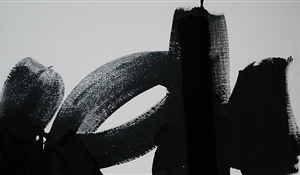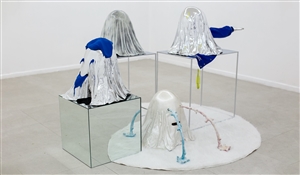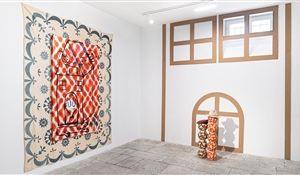About Ornamenting and Ornamental Things
24 Aug 2022Decorating: to adorn and embellish.
Adornment: a pre-made or improvised ornament that adds diversity, expression, and attractiveness to the tone.
Ornament: anything used to decorate other things.

Papier-mâché mirror frame
To understand concepts, we have to review the meaning of words. Taking the meanings of words as obvious leads to misunderstanding because, over time, the sense of the words changes, but this change does not necessarily change their inherent meaning. During recent months, I encountered some well-known artists who either include decorative aspects in their works or avoid such features obsessively and cautiously, while both have insistently condemned decorating and ornamenting. But why?
They probably understand words like "decorative" and "beautiful" to involve a sense of heavy pressure, the burden of which they prefer to avoid. For now, think about the meaning of decorative and beautiful, and we will return to it.
Reviewing Iran's arts and crafts1, especially from Safavid to the last years of the Qajar dynasty, we constantly see things such as miniature paintings, Gul-o-Murgh, Europeanizing, Papier-mâché, various types of carpet, Āina-Kāri, garden designing, tessellation, stucco, glazed pottery, murals, calligraphy, illuminated manuscript, Tughra, Muraqqa, under-glass painting, Termeh, Muqarnas, Murassa, etc., all have one feature in common, ornaments. Over hundreds of years, we have mastered ornamenting to the extent that we never leave a corner empty. We carpeted the whole floor and decorated all the walls with paintings, fabrics, calligraphy, tessellation, Āina-Kāri, and stucco. We also never left the things we carry to remain simple in appearance. We added patterns and colors to combs, hand-held mirrors, Kohl containers, Qalamdans, and even foods and confections to add beauty to them.
Looking closely at these arts and crafts, there are a lot of ornaments in them too. Margins of Muraqqas, illuminated manuscripts and paper marblings in texts, and even court letters and window glasses are full of adornment-oriented subtleties.

Tughra by Mirza Hassan Zarin Qalam
For instance, Tughra art was invented to create complicated beauty, followed by Mirza Hassan Zarin Qalam, whose works were full of ornaments, details, and manifestations. That is why his works were most suitable for decorating the houses of nobles. It is also notable that the title of one of the most influential cultural characters of the Qajar period directly refers to the person who is the subject of this text; Aliakbarkhan Mozayan ad-Doleh.
Before that, paintings from the Safavid period that were executed on the ceiling and walls of Chehel Sotoun, Hasht Behesht, and Ali Qapu palaces defined the conception of the ideal image with ornaments.

A page of Shahnameh of Shah Tahmasp
There is also a technique called Zar Afshani in miniature painting mainly used to ornament page margins, the perfect execution of which is evident in the Shahnameh of Shah Tahmasp. In this technique, a gold sheet is registered on the surface of a paper using moisture and a special method of strengthening paper or cloth. Zar Afshani was used as an ornamenting technique for papers, and its result was considered a unique abstraction. Unfortunately, only one of the pages adorned with this method is reproduced in the new edition of the Shahnameh of Shah Tahmasp. This was due to a false understanding of the execution complications of this technique; maybe the paintings were not considered worthy of spending time for ornamenting!
In general, adornments have had much more importance among the prosperous groups of society. However, regular people also benefited from it, even though its use was limited to copper containers, bindles, tablecloths, and gardens. The insistence on not leaving the appearance of things plain and empty and adding a sign of taste to it is actually proof of the importance and value of ornamenting in Iran.
Adornments were so valued in the Pahlavi dynasty that the faculty of decorative arts was established in this period resulting in impressive outcomes. The faculty noted Iran's history of art with a modern approach. Such activities were also done in apparently unrelevant fields to highlight beauty's importance. For example, the Chalous road was constructed with all its complications. It is a difficult, winding, but beautiful road.
Now let's go back to the words:
"Fine crafts": arts that are centered on subtleties. A translation of "visual arts" or "plastic arts."
"Beautiful arts": a newer translation of the same word.
"Visual arts": the translation that is prevalently used today.
As if there is an attempt to remove beauty from art!
A while ago, in an essay about Persian carpets, the writer mentioned: "the carpet is not the house's ornament, it is a part of the house, it is the house itself." The writer has tried to free the Persian carpet (as a thing he/she loved) from the ominous shadow (as he/she thought of it) of being a decorative object, and for this purpose, he/she included meaningless phrases with a level of sloppy poetry in his/her text to consider the carpet as the house itself but absolutely not its ornament!
Over time, we acquired access to the West's and far East's visual resources as we entered the 21st century. Therefore, we faced appearances adorned with simplicity, distancing us from our desire for ornaments, even though these Western and Eastern versions have not reached a dominating position (in some cases, the incomplete dominance of Western and Eastern versions, combined with the background of a tendency toward ornaments has led to strange visual chaos the study of which is obviously not in the capacity of this text.)
Let's return to the present. We cannot simply consider words like "decorative" (used to refer to adorning the living place) and "beautiful" as repulsive because they are historically rooted in this geographic context. Persian aesthetics fundamentally value beauty and decorating. This does not defy communicating meaning. Whatever the meaning, whether bitter and painful, descriptive and cheerful or even an image that basically lacks sense, it can be decorative and beautiful. The Paisley's form, which represents a bent Cypress mourning for the death of Siavash, is an example that proves that a form can be an ornament and, at the same time, bitter and sad. It demonstrates that ornamenting does not obstruct meaning.
This text neither disapproves of arts that avoid adornment nor approves of arts centered on adornment. It is just an attempt to point out that there is no certainty and that art is still not bound to limits. It is also a description for the Iranian artist who is probably proud of the carpet and decorates their Aush Reshteh with kashk and mint in order not to be afraid of decoration and adornment!
In conclusion, I presume instead of struggling against the word "ornamenting," we can consider it as one of the appendages of aesthetic order, consisting of two fundamental components, that is, the form and the meaning included in a whole, and use it whenever we need.
Cover and slider image:
- www.sothebys.com






